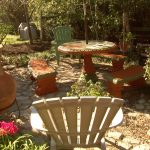Time for Trees
encore date: December 18, 2014
original air date: November 8, 2014
It’s tree planting time, so let’s pick a few trees for sun or shade with Crystal Murray from Far South Wholesale Nursery! On tour, a young couple framed their garden-on-a-budget around native trees that came with their land. Find out how to grow bald cypress, Daphne’s Plant of the Week. Plus, she explains why trees turn color in fall. John Dromgoole shows how to protect beds or container plants in freeze with row cover.

 April Hendricks
April Hendricks Daphne Richards
Daphne Richards John Dromgoole
John Dromgoole